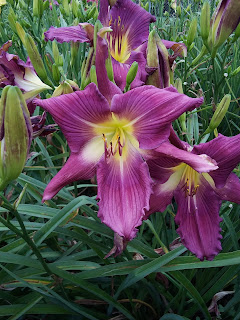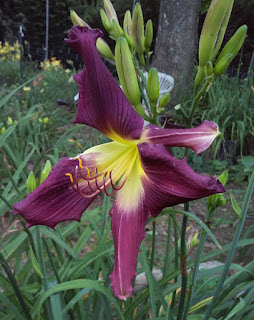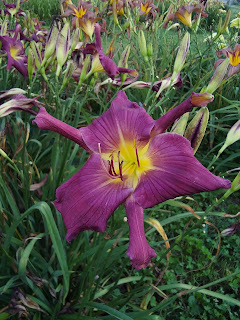Cultivar Name: Vorlon Empire
Seedling Number: VESLF 4
Bloom Diameter: 5.5”
Scape Height: 26”
Branches: 3
Bud Count: 15
Bloom Season: Mid-Late
Rebloom: No
Color/Description: Deep burgundy purple with a bluish wash strongest at petal edges, dark purple eye radiating into glowing green to gold throat.
Ploidy: Dip
Bloom Habit: Diurnal
Foliage: Dorm
Fragrance: UNK
Pod Parent: Vorlon Encounter Suit
Pollen Parent: Lavender Feathers
Flower Form: UF Quilled Crispate
Year Bred: 2013
Rust Resistance: A+/3 years
Fertile: Both ways
For a complete list of my available daylilies and pricing, click here.
Comments: Vorlon Empire is gorgeous and vigorous and showed very high rust resistance throughout the last three years of my breeding program. A great combination of the two parents, the flower is a very clear burgundy purple. Sometimes the flower has a thin, darker edge on petals and it always shows a dark-eyed phenotype similar to pod parent Vorlon Encounter Suit, while the color is in the clarity range of the pollen parent Lavender Feathers.
The rust resistance was of the highest level through the three years I tested it. It is on par with the pollen parent, and is an improvement on the rust resistance of the pod parent. The plant always gives a good show and is an excellent garden plant. For breeding, it shows much potential for rust resistance, unusual form flower, intense purple and lavender coloring, interesting eyes, and vigorous, fast increasing plants. Purple is difficult to photograph, often looking too reddish or too bluish, depending on the lighting levels. Late evening photos are always too bluish, but it is my favorite time of day to take photos because I can test the substance of the flower and how it holds up to that days weather in the late evening. Photos in full light look far too red and often wash-out. Late afternoon in my gardens where there are shade have given the most accurate color, and I will note below time of day. The color is a clear burgundy purple, not blue. Vorlon Empire has been one of my favorite diploid seedlings for many years. It is one that I suspect I will retain for many years to come. It is very welcome in the mid-late season, adding a very exotic dash of excitement to the garden when so many earlier cultivars are finishing up.



%2011.jpg)



